SOPs, The Modern Worker & How Pharma Companies Must Evolve The "Read & Understand" Model
By Mark Simon and Ben Locwin

Pharma companies have used “read and understand” approaches with standard operating procedures (SOPs) as a core component for staff training for many years, and from a compliance point of view, this practice has been sufficient. But there is a difference between “sufficient” and “exemplary.” We’ll explain more on this below.
Document management systems (DMS) ensure that all new and updated documents have detailed metadata that can tell you all the parties who created, reviewed, and edited the documents, plus dates and times when each sign-off occurred (document audit trail). The systems also provide employees with assurances that they are accessing the most up-to-date, effective versions of each document.
Learning management systems (LMS) provide access to the documents in the document management system – along with other online training courses – and can produce reports of company-wide, department-wide, group-wide, and individual performances for job-related skills.
These two systems provide a gateway for employees to be qualified to do their jobs, and regularly scheduled internal and external audits ensure that pharma organizations are consistently in line with compliance rules and regulations.
What Could Be Wrong With The Current Paradigm?
As the saying goes, “There’s a difference between ‘science’ and ‘compliance’”; being compliant doesn’t mean that best practices are in use, just that the minimum requirements are being met.
That’s a big difference.
People generally don’t like to admit this out loud, but one of the dirty little secrets with “read and understand” training is that nobody in your company likes reading those SOPs. Even worse:
- The antiquated formatting of the documents is very difficult to read, leading to low comprehension and recall of content that is required for employees to do their jobs.
- Many employees do not even read the documents at all. In almost all cases, the training requirement is to open the document, read the document, and close the document. However, statistics are dreadful for the average time documents are open for reading (in some cases literally single-digit seconds) – indicating that the “reading” part is an oft-skipped step.
- The SOP assignments are often so overwhelming (in number; maybe underwhelming in content!) that the hidden message is to simply get through the read and understand requirements, and worry about the job tasks later. You don’t believe this? My last client, a global biopharma organization, assigned over 100 SOPs for me to complete within my first four to six weeks there. I can assure you at least half of those assignments had nothing whatsoever to do with my job there.
What is the percentage of people in your organization who are completing their read and understand assignments without really reading them – not to mention understanding them?
It's also worthwhile to point out that general reading issues, particularly in documents with a long, paragraph-by-paragraph format, contribute to the problem. According to the U.S. Department of Education, 54% of U.S. adults 16 to 74 years old - about 130 million people - lack proficiency in literacy, reading below the equivalent of a sixth-grade level. Other studies support the findings of the U.S. Department of Education. For example, according to The Literacy Project, the average American reads at the seventh- to eighth-grade level, and according to the American Medical Association, medical information for the public should be written at no higher than an eighth-grade reading level. 1
Pharma management may counter that their employees are a significant cut above the “average U.S. adult,” but that’s no reason to carry on with an infrastructure of difficult-to-read documents in an environment that relies heavily on read and understand training.
Let’s Acknowledge The Problem
In general, fixing this issue must start with an acknowledgement that improvements may be helpful. Pharma organizations are full of old-school employees who have been working in this industry for many years and have gotten used to reaching for a three-ring binder, locating the needed document, and reading through long, numbered paragraphs of 12-point Times New Roman. (Or NOT really reading, as we discussed earlier!)
The modern worker doesn’t learn like this outside of their daily work confines.
I am not just referring to the younger digital learners who grew up spending countless hours in front of screens. Both the young and old are using the internet today. According to census.gov, the percentage of households in the U.S. using the internet grew from 74% in 2013 to 85.5% in 2020. 2 Chances are pretty good that YOU are reading this article on some type of electronic device.
So, the data tell us that a high percentage of people use the internet, and it would be a logical jump to assume that they are reading and learning very differently than they did during pre-internet days. While people certainly still read long passages online, the content is often broken up into more manageable “chunks” of information, there are usually more visuals, and embedded links are almost always included for the reader who needs additional context for topics that are unfamiliar.
Perhaps you’re skeptical about using an internet-style of learning in the workplace? Well, it’s important to mention that the notion of “chunking” information is not exactly a new phenomenon. Cognitive psychologist George Miller conducted extensive research in the 1950s and published a document that showed the probability that recall of information is greater when a "chunking" strategy is used.3 Among other things, Miller’s cognitive load studies led to the format chosen by AT&T for phone numbers in the U.S.
As such, you can thank Miller that your phone number is not 2223334444. Instead, your number format is much easier to remember and share with friends: 222-333-4444. “Chunked.”
Solutions
Fortunately, most organizations have already taken a big first step forward by reducing or eliminating the reliance on paper-based SOPs, work instructions, and policies. Employees now access work documents through document and learning management systems and, importantly, that step by itself helps to ensure that employees are always accessing effective versions of each document.
However, the traditional format is still difficult to read, which leads to lower comprehension of content and incomplete reading of critical information. There are better document designs that can increase comprehension and reduce the time it takes to find the information you need.
To fix this problem, let’s start with some goals that we’d like to attain:
- Make documents easier to read start-to-finish
- Design documents for online viewing/reading
- Make it easier to navigate through the documents
- Make it easier to access related documents
- Allow printing in traditional paper-based format
Below is an example document that should look very familiar to you. This is the traditional SOP format, following templates provided by online resources.
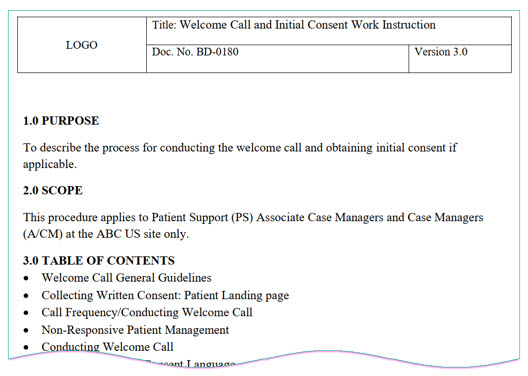
Now, let’s look at a potential enhancement to that document, with a few modifications.
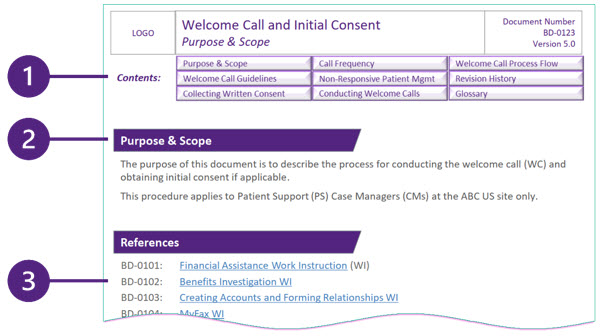
The enhancements shown here include:
- A contents navigation bar, with internal links to the key sections in the document. This allows for quick access to any/all content in the document. Next Page and Previous Page buttons are also included at the bottom of each page.
- Bold, clear section titles for quickly finding/identifying the section that the reader needs to view.
- Sans-serif font for better online reading; external links to related documents.
Here is an additional example.
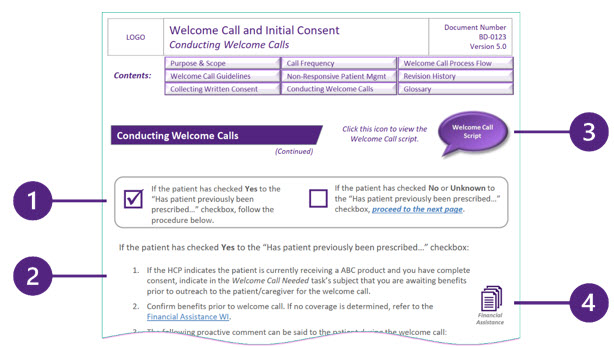
The enhancements shown here include:
- Subtle graphical designs to help content stand out and to separate content into smaller, more readable “chunks.”
- Short paragraph presentation and single-digit numbered lists.
- Occasional graphical icons that are linked to extended details if needed.
- External links within the content to related documents or websites.
Acquisition Time Is Faster For What Matters
In fact, a small group (n = 16) comparison tested for acquisition of content within the more traditional format versus the modernized format suggests that, for finding what readers need within a page, the modernized layout provides a 25% faster average seek result for correct information, t(11) = 6.40, p < .05).
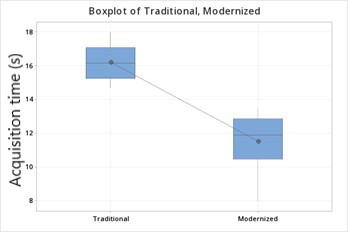
Figure 1: Traditional layout vs. modernized layout, measure of acquisition time to find relevant information within document (16.2 sec vs. 11.6 sec average)
Moments Of Need
A final step in the solution involves the moment of need model by Conrad Gottfredson and Bob Mosher.4 The five moments of need that they identified are:
- Learning for the first time
- Expanding knowledge base
- Remembering and applying learned concepts
- When things don't go according to the plan
- When change occurs
Pharma organizations, of course, are keenly aware of the first moment of need – but employees should have easy access to the documents for their other moments of need after the initial training is complete.
Portal Pages
Document management systems provide one option, but a portal page is better, faster, and (potentially) more robust.
What’s a portal page? It’s a page (either a PDF or web-based) that provides a list of links to:
- Work documents
- Job aids
- Company and departmental pages on the company intranet
- Industry information on the internet
Portal pages can be very simple to design. At the most basic level, it can be accomplished with a list in MS Word (perhaps a two-column table with the name on the left and a brief description on the right), which is saved as a PDF file.
Send the PDF file to all applicable employees, with instructions to save the file on their desktop, and they will have access to all that information at their fingertips anytime they need it.
You can also take it one step further by creating a web page on your company’s intranet – but either way, you are helping all your employees to access the information they need very quickly, no matter what the moment of need is.
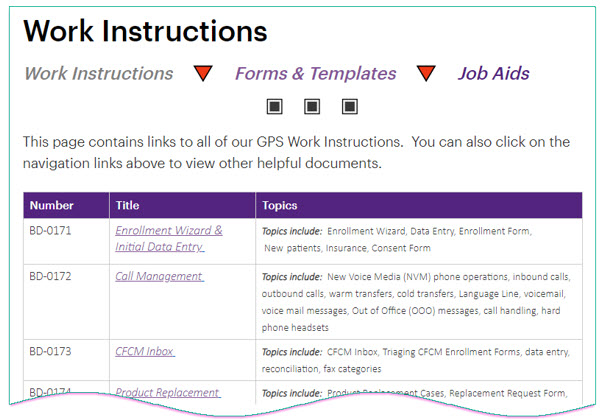
Summary
In many cases, the document-centric environment within most pharma organizations has not adapted very well to the modern worker, who now is accustomed to learning information online and via electronic devices.
Research shows that there are literacy issues among a high percentage of the population, and long paragraph formats will likely have a negative impact on that population, not to mention adults with reading issues such as dyslexia.
A redesign of your company’s controlled documents would improve employee reading and understanding, and it will also greatly improve employee performance during many other moments of need.
References
- Marchand, L (March 22, 2017) “What is readability and why should content editors care about it?” Center for Plain Language, Retrieved from https://www.wyliecomm.com/2021/08/whats-the-latest-u-s-literacy-rate/
- Nietzel, M. (September 9, 2020) “Low Literacy Levels Among U.S. Adults Could Be Costing The Economy $2.2 Trillion A Year” Forbes Magazine, Retrieved from https://www.forbes.com/sites/michaeltnietzel/2020/09/09/low-literacy-levels-among-us-adults-could-be-costing-the-economy-22-trillion-a-year/
- Miller G. (1956) “The magical number seven, plus or minus two: Some limits on our capacity for processing information.” Psychological Review. Retrieved from https://www.ncbi.nlm.nih.gov/pmc/articles/PMC4486516/
- Gottfredson, C. and Mosher, B. (2014) “The 5 Moments of Need” Retrieved from https://www.5momentsofneed.com/
About The Authors:
Mark Simon is principal documentation & training consultant at HiMark Solutions and has more than 25 years of hands-on experience with numerous clients in a variety of vertical markets. His achievements include serving as an adjunct professor in the Instructional Design graduate program at UMass-Boston. He has been published in many professional publications and shares his experiences often at professional shows and conferences.
 Ben Locwin is a pharmaceutical industry executive and leader of many error-reduction programs in use across the industry. He has worked on batch record, SOP, and work practice redesigns to focus on the principles of human learning and behavioral neuroscience. He has been featured media such as USA Today, The Wall Street Journal, the Associated Press, and other publications.
Ben Locwin is a pharmaceutical industry executive and leader of many error-reduction programs in use across the industry. He has worked on batch record, SOP, and work practice redesigns to focus on the principles of human learning and behavioral neuroscience. He has been featured media such as USA Today, The Wall Street Journal, the Associated Press, and other publications.
